Photo

I just gave my white pine a spray with water, for some reason it seemed to be getting extremely dusty.
7 notes
·
View notes
Photo

Azalea
YR: 2000
Flowering
NOT FOR SALE
Spring time is here and my Azalea is blooming with the most magnificent pink flowers.
#bonsai#gardening#garden#pink#pink flowers#flowers#flowering#spring#plants#Azalea#rhododendron#Bonsai
14 notes
·
View notes
Link
#bonsai#tree#garden#south africa#johannesburg#for sale#plants#trees#natural#maple#elm#fig#website#bonsai care
1 note
·
View note
Text
Huge Japanese Maple
I acquired a huge Japanese Maple which is a fairly rare find. It was in some serious need of attention.
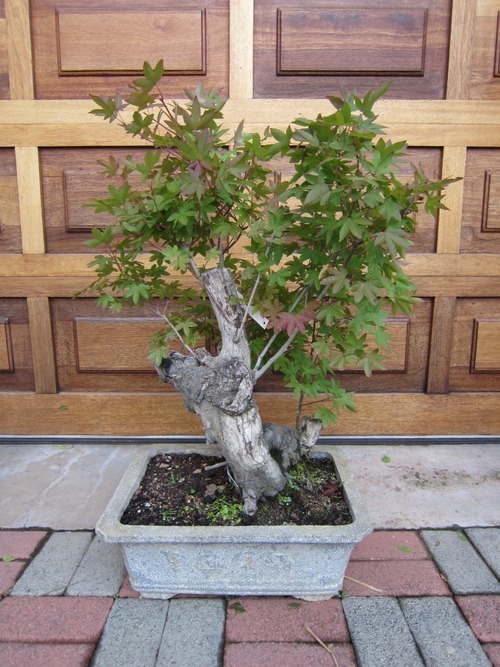
Look at the size of this trunk..

And another photo...

There are a few cut wounds which I will have to do some carving but for now I just wanted to do an initial training stage. Also a main problem is that all the branches are very upright, these would need to be bent downwards.
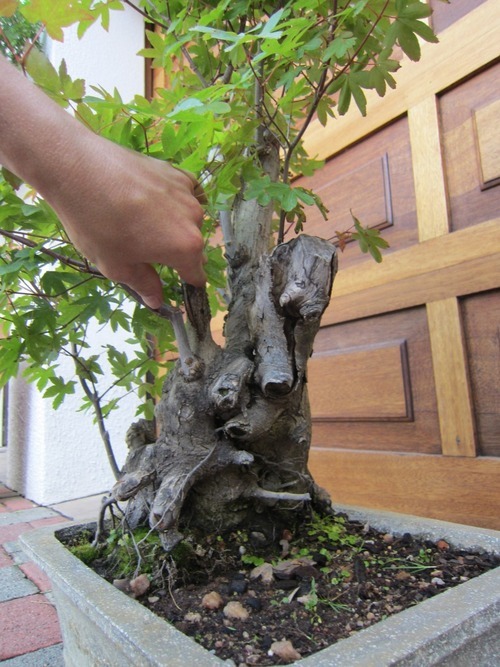
I did a first stage of bending the main branches pulling them down with fishing gut.

I started with a bit of wiring, I protected the branches because Japanese Maples have very sensitive bark and is damaged easily.
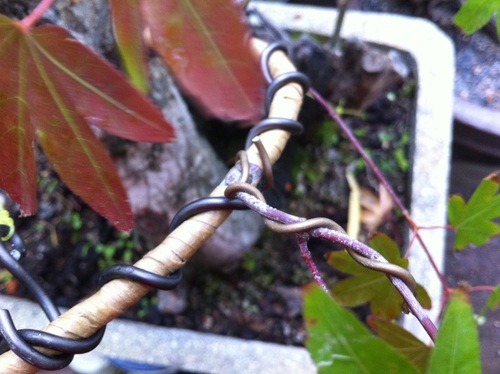
I then completely wired the whole plant positioning everything exactly where I wanted it.

I was extremely happy with the outcome, the bonsai was starting to look like a real tree. A few weeks later, it started throwing out new growth. A lovely red.

The bonsai started to look good with all its new leaves.
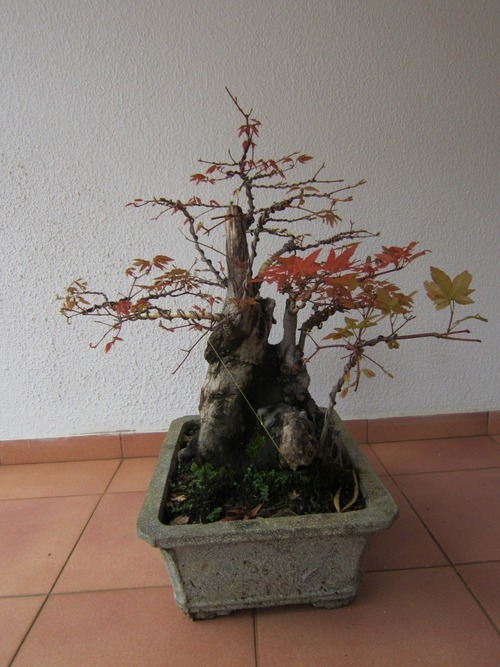
I will need to remove all the wire soon and do some carving. Then I will wire the tree again once there are some new branches. I need to remove the wire because it is already starting to cause a bit of wire damage after just a few weeks. Finally I will need to re-pot this Bonsai at the correct angle for the front view.
The trunk is beautiful and natural...

The wiring looks interesting from underneath with all the new leaves.

.
And after just a few weeks...
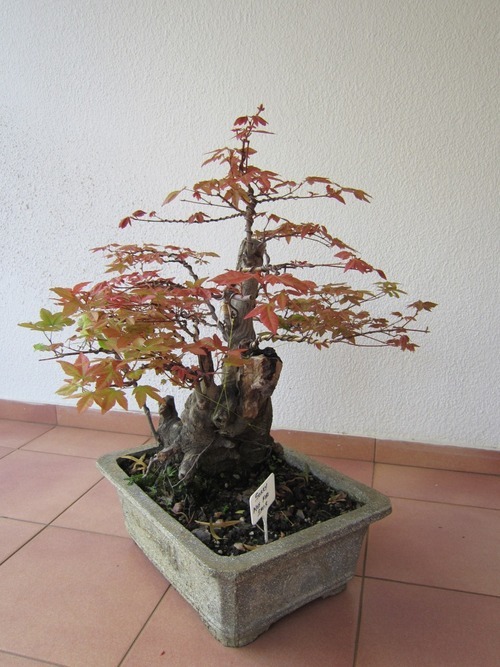
#Bonsai#miniature tree#tree#garden#plant#Maple#japanese#japanese maple#pots#trunk#red#bright#art#wiring#training#artist#repot#moss#nature#chinese
12 notes
·
View notes
Text
Red Japanese Maple
Acer palmatum Atropurpureum: Japanese Red Maple
YR: 1989
NOT FOR SALE
My new Japanese Maple, I have been looking for a Red Japanese Maple for ages. The colours are simply amazing. This tree does however have a horrible V trunk so some serious work is needed.
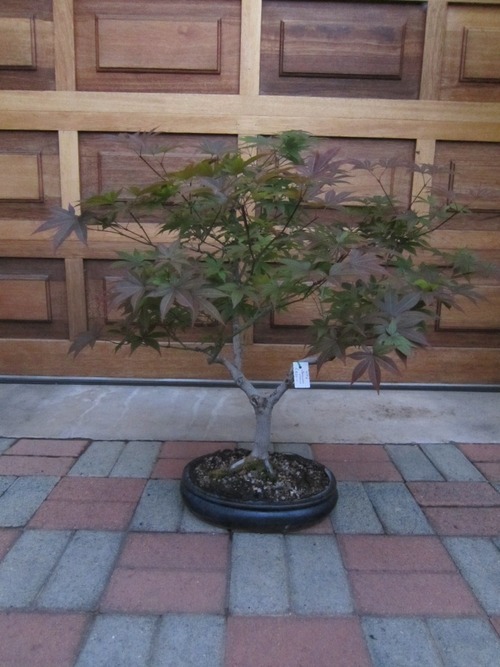
I started by planting the bonsai in a new pot, the brown pot better suits the plant in my opinion. I planted it at a slight angle to allow for the thinner trunk to be used as a first branch rather than a second trunk.

I then used the technique shown below to pull branches down, this was followed by defoliating the whole tree.

Shown below is the finished product. When defoliating, I like to leave the odd leaves at the end of branches to ensure the sap continues to flow, as the new leaves start to come out, I remove the old leaves.

After about 5 weeks, the new leaves have started coming out and all the old leaves have been removed. The structure of this tree still needs to be developed but the main structure is there with the V now converted to a first branch.
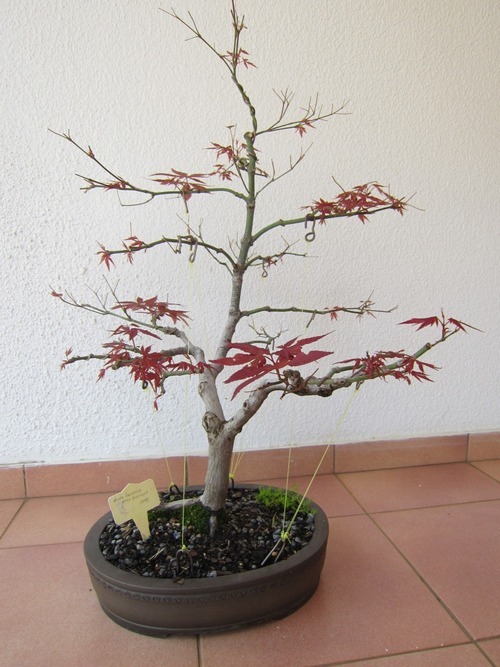
This tree has a nice matured trunk for a Japanese Maple. The moss adds to the effect of a Bonsai.

Finally, the image below shows the new leaves coming out. They are a beautiful deep red colour and will slowly turn slightly green again. When autumn arrives, the leaves will turn red again before falling off.

Currently my Red Japanese Maple is looking like this.

#Bonsai#Maple#Japanese#Japanese Maple#Red Japanese Maple#Chinese Maple#Red#Colourful#plants#tree#bonsai pot#pot#trunk#red leaves#Art
9 notes
·
View notes
Photo


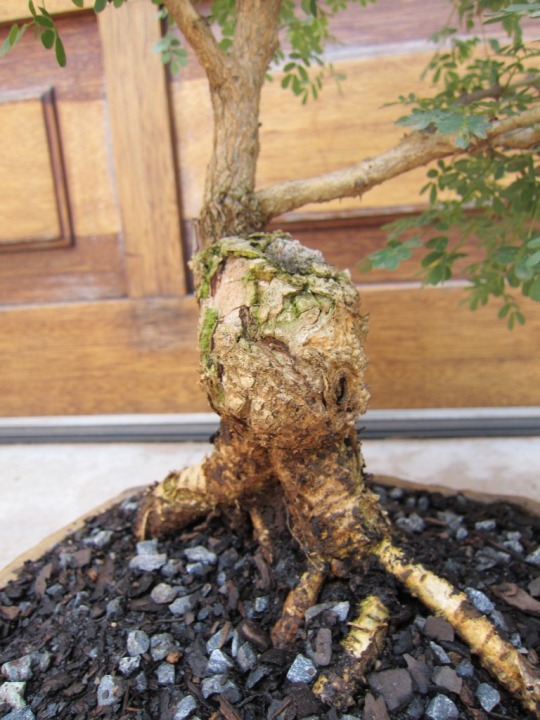
Acacia burkei: Black Monkey Thorn
YR: 1998
Outdoor, Indigenous
R 450
8 notes
·
View notes
Photo


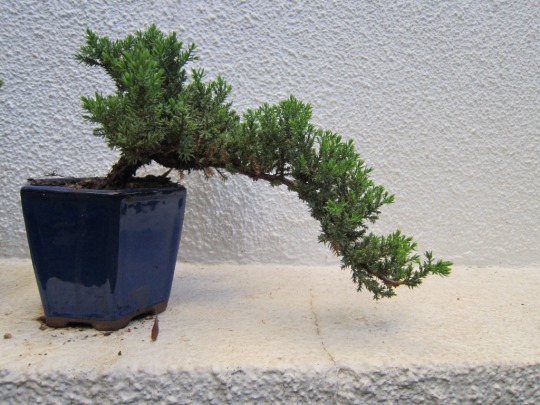
Juniperus procumbens Nana
YR: 2006
Outdoor, Hardy
R 220
9 notes
·
View notes
Photo

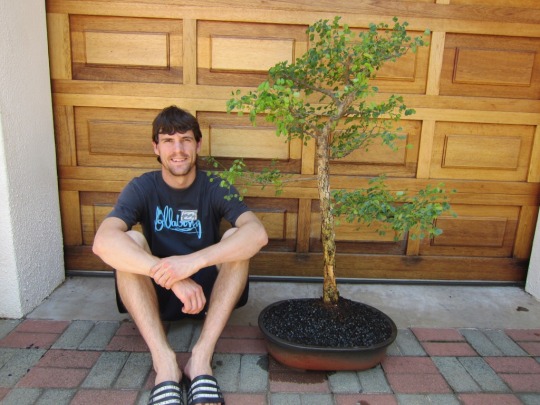
Acacia nigrescens: Knob Thorn
YR: 1994
Outdoor, Indigenous
R 2100
6 notes
·
View notes
Photo

Japanese Maple
YR: 1993
Oudoor
R1100
3 notes
·
View notes
Photo
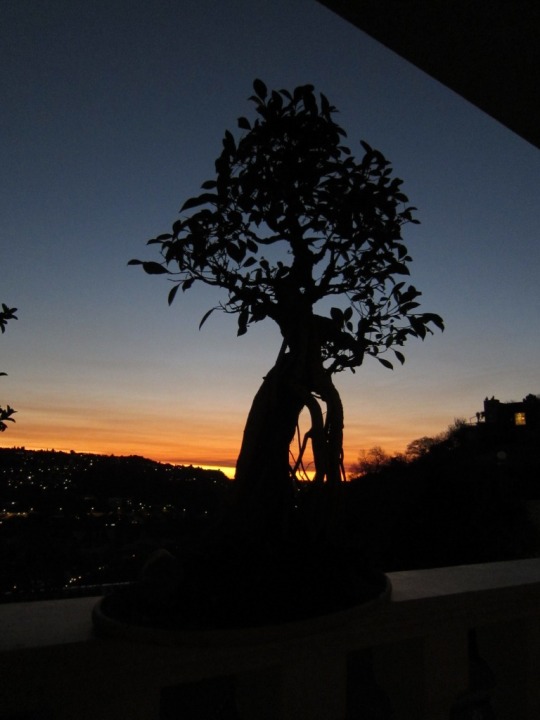

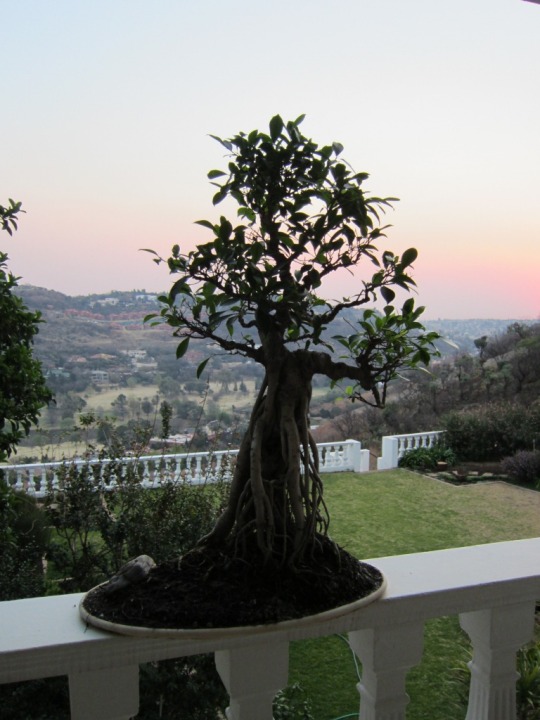
Ficus Microcarpa
YR: 1975
Indoor
NOT FOR SALE
This tree is one of my most precious bonsai’s. I have had it for a couple of years now.
#Bonsai#Ficus#Ficus Microcarpa#Plants#Trees#bonsai#garden#gardening#majestic#plant#sunset#tree#view#photography
19 notes
·
View notes
Photo

Bonsai is not, strictly speaking, a Buddhist tradition. It’s a Japanese development of the Chinese art of penjing (盆景) dating back to the Tang Dynasty. Both bonsai and penjing, however, were popular among Buddhist scholars in China and Japan—especially those of the Chán and Zen sects. It’s not hard to see why. The art of bonsai requires great care and concentration. Whether pruning shoots or wiring branches, the bonsai enthusiast must be mindful of the effects of every action upon the tree. And, unlike sculptors or painters, the bonsai artist works with a living medium. The bonsai tree is not a static creation, but a growing and changing work of art that embodies the principle of impermanence. The attentiveness and focus required can be similar to śamatha practice and I’ve often found working with my trees to be a meditative experience.
33 notes
·
View notes
Photo

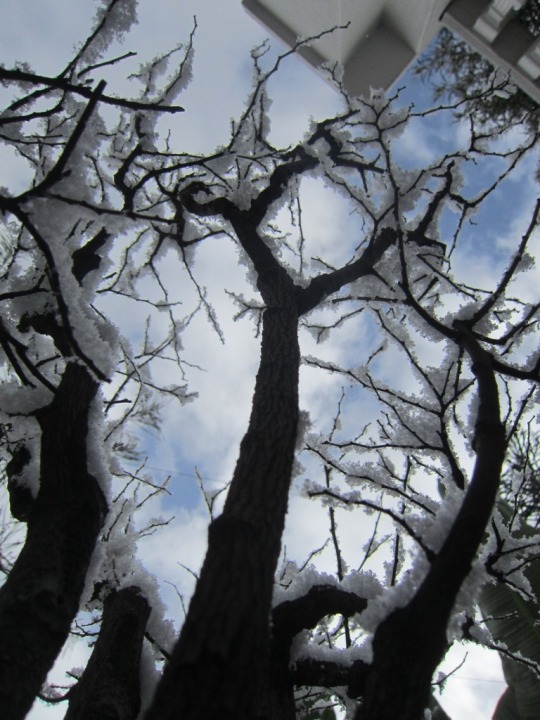

Celtis Africana: White Stinkwood (excuse the pun)
YR: 1990
Covered in snow this winter, looks like I took the photos while standing in a forest underneath the tree.
10 notes
·
View notes
Photo

Acer buergerianum: Trident Maple
YR: 1995
Deciduous
NOT FOR SALE
One of my Chinese maples going into winter full of colour, looking great :)
10 notes
·
View notes
Photo



Ulmus parvifolia: Chinese Elm
YR: 2004
Deciduous outdoors
R250
Indoor/Outdoor
Chinese elms are very hardy and can grow happily indoors or out. The like full sun and can handle the cold. However during the hottest months of summer they prefer semi-shade. If they are kept indoors, it is necessary to have them near a window with plenty of light. Indoors Chinese Elms can remain evergreen but are deciduous outside.
Watering
Maintain soil moist in summer but not saturated and water slightly less in the winter allowing soil to dry slightly on the surface between watering.
Re-Potting
Re-pot every two to three years in early spring. Be careful as the roots are very soft and are easily damaged. When trimming make sure to use sharp tools in order not to squash the roots and ensure a nice clean cut.
Training
A Chinese elm can become very 'messy', make sure to keep all the new growth pinched back to two leave. Responds well to trimming in mid-summer with tons of new shoots. Wiring is a good way to train younger trees but older branches can be quite brittle. With all the vigorous growth, the easiest way to train a Chinese elm is to pinch out the new growth before a leaf which is pointing in the direction you want the branch to go.
13 notes
·
View notes
Photo




Ficus burtt davyi
YR: 1989
Indoor
NOT FOR SALE
31 notes
·
View notes
Photo
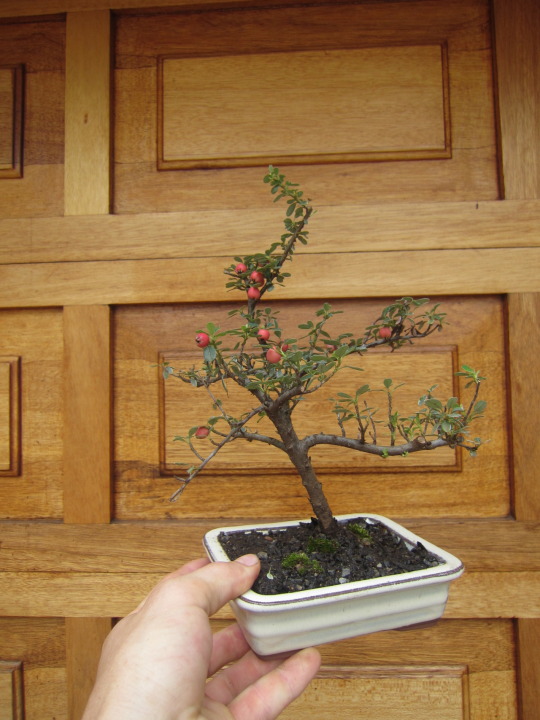
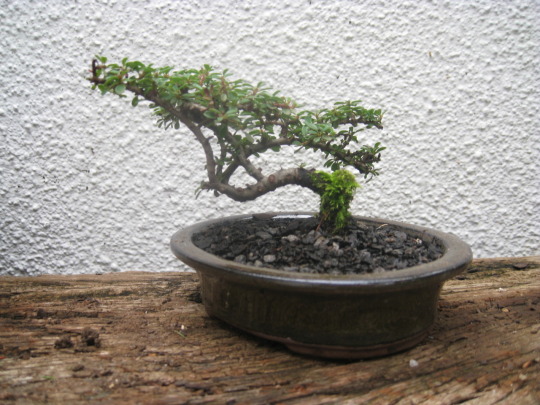

Cotoneaster
YR: 2007
Flowering/ Berries
R100
Outdoor
Cotoneasters are mostly landscape plants and they will survive in a great part of sunlight. In the winter the roots needs to be protected from severe freezing. Bring indoors when bad frost has been forecasted. A cotoneaster may be kept indoors all year round as long as it’s exposed to a lot of sunlight. In cold climates the cotoneaster is deciduous and in warmer climates they can be evergreen.
Re-potting
Every one to two years the bonsai should be re-potted. Just remember that these plants don’t like to have bare roots. This is one of the best plants to use for air layering.
Watering
Cotoneasters don’t like to be very wet, this can cause root rot. However a Cotoneaster does not like its roots to dry out. In summer water when the soil appears to be dry on the surface and in winter try keep the soil slightly less moist.
Training
Cotoneasters throw out growth vigorously so unwanted shoots must be cut off. Wiring can be done but the respond best to constant trimming. Cut back shoots to two or three leave encouraging dense layers in a well structured network.
8 notes
·
View notes
Photo
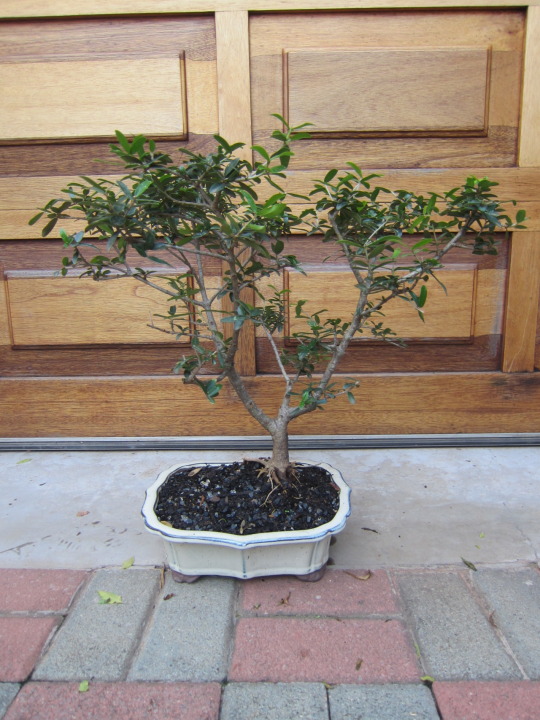

Olea europaea: Wild Olive
YR: 2002
Evergreen/ Indigenous
R350
Outdoors
Wild Olives often mistaken for the Olive tree are extremely hardy. They can handle drought and frost. They like full sun but do well in semi-shade.
Watering
They can handle dry soil but flourish with moist soil in summer, water less in the winter months.
Re-Potting
Can be potted any time of the year in a slightly deeper pot. Every couple of years older trees will need to be re-potted.
Training
They respond well to wiring. Constant pruning and pinching back to two leaves is a good idea creating very dense layers and helps to drastically reduce the leaf size.
5 notes
·
View notes